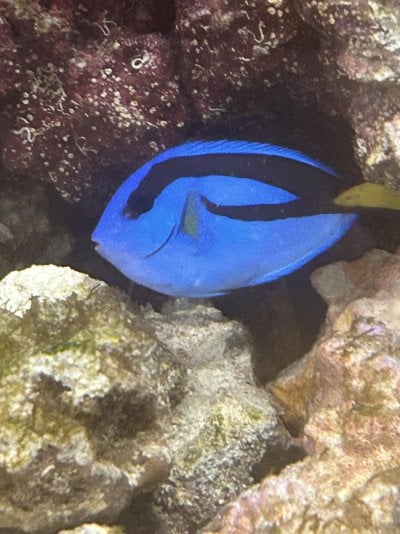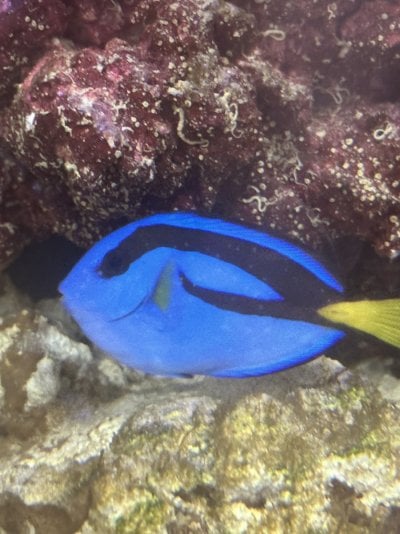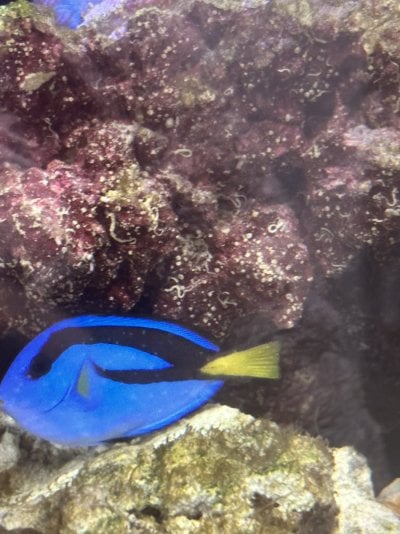Hi all,
I'm quite new to Saltwater, and the forum. But I have a new blue tang, for 1.5 weeks, no QT tank unfortunately so went into the display tank. The tank overall is about 2 months old approx.
Has been presenting since yesterday with scattered white dots, and slightly more pale coloration especially on the underbelly. The dots and coloration is more noticeable with the lights off, she's usually a bit more pale at night anyway. Not much behaviour change recently, but some flashing this evening for the first time. No increased respiratory rate which I can see, still eating & active.
I have attached a few photos with the lights off, to show the dots. When trying to inspect, it does appear as if she has bumps on the skin (More noticeable when the light is on though). Which makes me think it may not be ich, but rather Lymphocystis, or something else perhaps. There does seem to be one single white dot on the left pectoral fin also and a few on the tail.
The tank is 5FT cade 1500, so 640L total system volume, maybe 560L display volume. There's corals in there so can't treat the tank with any Ich treatments, no QT available but can set one up if needed. Other fish so far look fine, acting normally without any similar bumps/spots.
Parameters
Ammonia: <0.25ppm (Using API, looks ever so slightly green, not quite at 0.25 marking). I'm worried this may be increasing stress but I did do a small water change and dosed prime too.
Nitrite: 0ppm
Nitrate: 0ppm (Was 2.5-5 yesterday)
Temp: 26.8c
Salinity: 34ppt
PH: 8.2
Calcium: 380ppm
Phosphate: 0ppm
Thanks in advance



I'm quite new to Saltwater, and the forum. But I have a new blue tang, for 1.5 weeks, no QT tank unfortunately so went into the display tank. The tank overall is about 2 months old approx.
Has been presenting since yesterday with scattered white dots, and slightly more pale coloration especially on the underbelly. The dots and coloration is more noticeable with the lights off, she's usually a bit more pale at night anyway. Not much behaviour change recently, but some flashing this evening for the first time. No increased respiratory rate which I can see, still eating & active.
I have attached a few photos with the lights off, to show the dots. When trying to inspect, it does appear as if she has bumps on the skin (More noticeable when the light is on though). Which makes me think it may not be ich, but rather Lymphocystis, or something else perhaps. There does seem to be one single white dot on the left pectoral fin also and a few on the tail.
The tank is 5FT cade 1500, so 640L total system volume, maybe 560L display volume. There's corals in there so can't treat the tank with any Ich treatments, no QT available but can set one up if needed. Other fish so far look fine, acting normally without any similar bumps/spots.
Parameters
Ammonia: <0.25ppm (Using API, looks ever so slightly green, not quite at 0.25 marking). I'm worried this may be increasing stress but I did do a small water change and dosed prime too.
Nitrite: 0ppm
Nitrate: 0ppm (Was 2.5-5 yesterday)
Temp: 26.8c
Salinity: 34ppt
PH: 8.2
Calcium: 380ppm
Phosphate: 0ppm
Thanks in advance



















